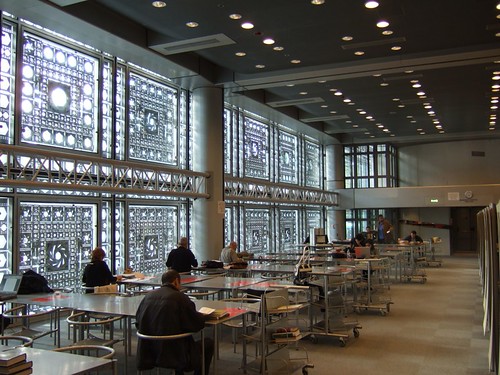My initial interests in interactivity and environmental awareness stem from a cursory look at some of the following projects as I have come across them, with little understanding of the systems behind them or in general what physical computing is about.
Automation - are buildings too complex for users?
The first and obvious architectural application of physical computing is automation of building systems in response to environmental stimuli - for example adjusting the position of shading or photo voltaic panels based on sun position, turning on/off lights based on occupancy and levels of daylight, adjusting ventilation (opening/closing windows) and turning on/off mechanical heating and cooling systems based on temperature. These computerised controls are broadly referred to as Building Management Systems (BMS) and are often largely unnoticed by building occupants.
The mantra with sustainable buildings, particularly solar passive houses, is that they need active users - windows, curtains etc must be opened/closed at correct times and if they are not, the building can perform significantly worse than a conventional building! Automated systems are common in new commercial buildings and perhaps for this reason could also be important in houses.
A visually expressive example of an automated system is Jean Nouvel's Arab World Institute brise soleil which is a beautiful array of 240 motorised apertures evoking traditional Islamic screens.
 |
| Arab World Institute, Paris, architect Jean Nouvel, 1981-87 - the brise soleil seen from interior |
 |
| Masdar City Center design competition winning entry, LAVA, 2009 - solar umbrellas in public plaza |
Making the intangible tangible
The next projects are interactive art installations. I, like Vanessa Wang, keep coming back to Scott Snibbe's Boundary Functions. I first saw this project when I was experimenting with abstracted Voronoi diagrams to arrange program and divide space in a second year architecture studio led by Iain Maxwell.
 |
| Boundary Functions, Scott Snibbe, 1998 |
On questioning personal space, this time in relation to machine (can you be intimate with a machine?), I also very much liked a student project that Bert Bongers showed at the 2007 AASA Conference. It was an installation (creature) that had long stick-like limbs and picking up movement or proximity would lean over to be near you (is it leering at me or is friendly? is it invading my personal space? is it going to touch me?!)
 |
| Tuned Stair, Daniel Hirschmann 2006, Fabrica exhibition, Centre Pompidou |
 |
| Musical Stairs at Brion Cemetery, Carlo Scarpa 1970-72 |
 |
| Vittala Temple, Vijayanagara 15C |
 |
| Sky Ear, Usman Haque 2004, Greenwich |
The beginnings of a physical computing syntax
From reading a couple of background papers presented at the Sketching in Hardware 2010 conference a syntax, or taxonomy even, for interaction design begins to emerge.
Carla Diana talked about a natural user interface, exemplified by the the gestures used to control the iPhone's touch screen. Emphasising appropriate gestures, screen readability and ergonomics, Diana discussed the position of metaphor, abstraction, mapping, feedback, delight and personality in interface design.
Ellen Do elaborated on this theme, calling for a human centric view of designing interactions for example
- Hand: touch, press, pick up, hold, squeeze, gesture
- Body: sight, sound, sense, sit, stand, walk, sleep, movement pattern
- Environment: light, space, ambiance, navigation, context aware.
Do describes a responsive architecture as an environment that takes an active role, initiated changes as a result and function of complex or simple computations, but also knows me and the context it is in and establishes a framework of considerations for designing A-E-I-O-U:
- Activities: What are they doing?
- Environments: Where is it taking place? (eg location, noise, lighting, all the senses)
- Interactions: With whom are they interfacing? (eg talking, seeing, collaborating)
- Objects: What are they using? (eg chair, projector, keyboard)
- User: Who are they? (eg group, individuals, roles, demographic data)
One final project that I want to mention is the interactive white board style hacks for projectors and flat screens using Wii Remotes to track the position of a pen that has an infrared LED. In 2009 Leo Carson and Christine Murray led a group of other MDD students, with support from Mitchell Whitelaw and Gurdev Singh to successfully implement a version in Processing. They ended up setting Boon Jin Goh's Smoothboard, a program that already has more sophisticated features built in, for design crits in the architecture studios. On screen markups that can be recorded as stills or movies finally brings to digital presentations the immediacy and intuition of traditional iterative feedback processes using butter paper. You can see in the video below Gurdev enjoying marking up my project.
No comments:
Post a Comment